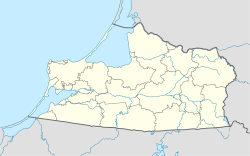Top Qs
Timeline
Chat
Perspective
Mayakovskoye
Rural locality in Kaliningrad Oblast, Russia From Wikipedia, the free encyclopedia
Remove ads
Mayakovskoye (Russian: Маяко́вское; German: Nemmersdorf; Lithuanian: Nemirkiemis) is a rural locality (a settlement) in Gusevsky District of Kaliningrad Oblast, Russia, located on the banks of the Angrapa River. It lies approximately 11 kilometres (7 mi) south-west of Gusev.[4]
The village became known during World War II on October 22, 1944 as the site of the first Soviet war crime on German territory against German women, French and Belgian POWs—the Nemmersdorf massacre.
Remove ads
History
Summarize
Perspective

The first documented mention of Nemmersdorf was in 1515 in a decree of the Insterburg Central Office.[5] At that time, it was part of the Kingdom of Poland as a fief held by the Teutonic Order,[6] and from 1525 held by Ducal Prussia. A prehistoric cemetery was located near the village.[4] Lithuanian church services were held at the local church.[7] From the 18th century it was part of the Kingdom of Prussia, and from 1871 to 1945 it was also part of Germany. In 1878, the population was predominantly employed in agriculture and cattle and horse breeding.[4] Between 1874 and 1945, Nemmersdorf was the principal urban locality in Gumbinnen administrative district within the county of Nemmersdorf-Gumbinnen in East Prussia. The municipality included thirteen rural communities.[8]
On October 22, 1944, Nemmersdorf was the scene of a massacre perpetrated by the Soviet soldiers against German civilians and French and Belgian noncombatants. Determining the facts has aroused controversy.[9]
Following World War II, Nemmersdorf came under the Soviet administration and was given its present name in 1946. The German population who survived the massacre either fled or were formally expelled in accordance to the Potsdam Agreement.
Remove ads
Demographics
According to the 2021 census, the village was 78.2% Russian, 4.3% Polish, 2.6% Armenian and 1.1% Belarusian.[11]
Religion
The Nemmersdorf stone church was constructed on the orders of Albert, Duke of Prussia, but it was completed after his death, in 1589. It was a simple rectangular bay near the Angrapa River, with sacristy facing east. In 1769, the church was renovated with an altar from the workshop of Isaac of Riga.[12]
Despite the damage in 1944, the church has survived two world wars. The nave has been preserved, now with a flat ceiling, but the tower is missing. After 1945, the church was used for other purposes and as a business building. In the early 1960s, it was rebuilt and now serves as a cultural center and library.
Until 1945, Nemmersdorf was predominantly Protestant with thirty Protestant clergy.[13] During the Soviet period, church life was discouraged. Only in the 1990s was the new Kaliningrad Oblast Evangelical Church established. The Parish belongs to the Provost's Kaliningrad Evangelical Lutheran Church in European Russia.[14]
References
Sources
Wikiwand - on
Seamless Wikipedia browsing. On steroids.
Remove ads





